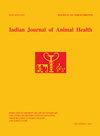最佳预混料日粮对不同蛋鸡日粮对白腿角蛋鸡生产性能的影响
IF 0.5
4区 农林科学
Q4 AGRICULTURE, DAIRY & ANIMAL SCIENCE
引用次数: 0
摘要
背景:在产蛋前2-3周喂食高营养密度的最佳日粮(BPD)是有益的,可以降低蛋鸡日粮的营养密度。方法:在19-40周期间,将180只16周龄的白角牛分为六层饲养策略(kcal ME/kg/%CP/%Ca)。处理为T0(BIS对照-2600/18.0/3.0)、T1(2500/180/3.0)、T2(2500/180/4.0)、T3(2500/170/4.0),T4(2500/160/4.0)和T5(2500/150/4.0)。研究期间记录了性能参数。结果:饲喂BPD对幼犬(16~18woa)CaI、PI和MEI无明显影响。3.0%的蛋鸡Ca(T0和T1)比4.0%(T2至T5)降低了CaI(p<0.01),蛋鸡日粮CP从18.0%降至15.0%降低了PI,但2500或2700 kcal/kg蛋鸡日粮不影响MEI(19-40 woa)。BPD不支持16%或15%的蛋鸡日粮CP(T4和T5),但允许将CP(T3)减少1.0%(18.0%至17.0%)以支持生产。T0(2600/18.0/3.0)的BPD(2700/18.0/2.5)和BIS(2007)蛋鸡日粮是在不影响FC的情况下支持BWG和改善蛋鸡EN、HDEP、FCDE、EFPR和PEI的最佳组合。本文章由计算机程序翻译,如有差异,请以英文原文为准。
Efficacy of Best Prelay Diet on Production Performance of White Leghorn Layers Fed with Different Layer Diets
Background: Feeding high nutrient density best prelay diet (BPD) 2-3 weeks before egg production is beneficial and may allow to reduce layer diet nutrient density. Methods: Total 180, 16-week-old White Leghorn pullets were assigned to six-layer feeding strategies (kcal ME per kg/%CP/%Ca) during 19-40 weeks. Treatments were T0 (BIS control-2600/18.0/3.0), T1 (2500/18.0/3.0), T2 (2500/18.0/4.0), T3 (2500/17.0/4.0), T4 (2500/16.0/4.0) and T5 (2500/15.0/4.0). These layers were fed with same BPD (2700/18.0/2.5) during 16-18 weeks. Performance parameters were recorded during the study. Result: Feeding BPD did not influence pullets (16-18 woa) CaI, PI and MEI. The 3.0% layer Ca (T0 and T1) decreased (p less than 0.01) CaI than 4.0% (T2 to T5) and layer diet CP reduction from 18.0 to 15.0% decreased PI but 2500 or 2700 kcal ME/kg layer diet did not affect MEI (19-40 woa). BPD did not support 16 or15% layer diet CP (T4 and T5) but allowed to reduce CP (T3) by 1.0% (18.0 to 17.0%) to support production. BPD (2700/18.0/2.5) with BIS (2007) layer diet in T0 (2600/18.0/3.0) is the best combination for supporting BWG without affecting FC and improving EN, HDEP, FCDE, EFPR and PEI in layers.
求助全文
通过发布文献求助,成功后即可免费获取论文全文。
去求助
来源期刊

Indian Journal of Animal Research
AGRICULTURE, DAIRY & ANIMAL SCIENCE-
CiteScore
1.00
自引率
20.00%
发文量
332
审稿时长
6 months
期刊介绍:
The IJAR, the flagship print journal of ARCC, it is a monthly journal published without any break since 1966. The overall aim of the journal is to promote the professional development of its readers, researchers and scientists around the world. Indian Journal of Animal Research is peer-reviewed journal and has gained recognition for its high standard in the academic world. It anatomy, nutrition, production, management, veterinary, fisheries, zoology etc. The objective of the journal is to provide a forum to the scientific community to publish their research findings and also to open new vistas for further research. The journal is being covered under international indexing and abstracting services.
 求助内容:
求助内容: 应助结果提醒方式:
应助结果提醒方式:


